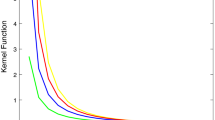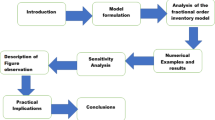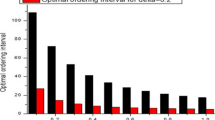Abstract
It is incontrovertible that involvement of memory has a great impact in inventory model. For any company, long past experience as well as short past experience have similar significant importance to manage the profit. Our proposed inventory model is leaded by two important factors: constant demand and deterioration. Here, we have introduced memory effect through the feasible ideas of fractional calculus. Also, we consider the order of fractional derivative as memory index. We calculate various type of costs viz total holding cost, purchasing cost, deterioration cost, shortage cost, salvage value. Additionally, optimal ordering interval, optimal starting shortage time and minimized total average cost are computed theoretically using the fractional calculus techniques. Effect of memory is justified by choosing a suitable numerical example. Finally sensitivity analysis for the model has been presented.


Similar content being viewed by others
Availability of data and materials
Data sharing not applicable to this article as no datasets were generated or analyzed during the current study.
References
Chang, H.J., Dye, C.Y.: An EOQ model for deteriorating items with time varying demand and partial backlogging. J. Oper. Res. Soc. 50, 1176–1182 (1999)
Chang, H.J., Lin, W.F.: A partial backlogging inventory model for non-instantaneous deteriorating items with stock-dependent consumption rate under inflation. Yugosl. J. Oper. Res. 20, 35–54 (2010)
Das, A.K., Roy, T.K.: Role of fractional calculus to the generalized inventory model. J. Global Res. Comput. Sci. 5, 307–316 (2014)
Das, A.K., Roy, T.K.: Fractional order EOQ model with linear trend of time-dependent demand. Int. J. Intell. Syst. Appl. 03, 44–53 (2015)
Das, A.K., Roy, T.K.: Generalized fractional order EOQ model when demand is stock dependent. Int. J. Math. Arch. 8, 1–14 (2017)
Das, A.K., Roy, T.K.: An imprecise EOQ model for non-instantaneous deteriorating item with imprecise inventory parameters using interval number. Int. J. Appl. Comput. Math. 4, 1–16 (2018)
Das, A.K., Roy, T.K., Jana, D.K.: Fractional order generalized EOQ model with demand-dependent unit purchasing cost under space constraints. In: Chapter 1, Recent Advances in Intelligent Information Systems and Applied Mathematics. Springer, Berlin (2019)
Diethelm, K.: The Analysis of Fractional Differential Equations. Springer, Berlin (2010)
Dye, C.Y., Chang, H.J., Teng, J.T.: A deteriorating inventory model with time-varying demand and shortage-dependent partial backlogging. Eur. J. Oper. Res. 172, 417–429 (2006)
Goswami, A., Chaudhuri, K.S.: An EOQ model for deteriorating items with a linear trend in demand. J. Oper. Res. Soc. 42, 1105–1110 (1991)
Hariga, M.: Optimal EOQ models for deteriorating items with time varying demand. J. Oper. Res. Soc. 47, 1228–1246 (1996)
Hariga, M.: An EOQ model for deteriorating items with shortages and time-varying demand. J. Oper. Res. Soc. 46, 398–404 (1995)
Jana, D.K., Das, A.K.: A memory dependent partial backlogging inventory model for non instantaneous deteriorating item with stock dependent demand. Int. J. Appl. Comput. Math. (2021). https://doi.org/10.1007/s40819-021-01136-w
Kilbas, A., Srivastava, H.M., Trujillo, J.J.: Theory and Applications of Fractional Differential Equations. Elsevier, Amsterdam (2006)
Kumar, A., Santra, P.K., Mahapatra, G.S.: Fractional order inventory system for time-dependent demand influenced by reliability and memory effect of promotional efforts. Comput. Ind. Eng. 179, 109191 (2023)
Lin, C., Tan, B., Lee, W.C.: An EOQ model for deteriorating items with time-varying demand and shortages. Int. J. Syst. Sci. 31, 391–400 (2000)
Miller, K.S., Ross, B.: An Introduction to the Fractional Calculus and Fractional Differential Equations. Wiley, New York (1993)
Mishra, P., Shah, N.H.: Inventory management of time dependent deteriorating items with salvage value. Appl. Math. Sci. 2, 793–798 (2008)
Pakhira, R., Ghosh, U., Sarkar, S.: Study of memory effect in an inventory model for deteriorating items with partial back logging. Comput. Ind. Eng. 148, 106705 (2020)
Pakhira, R., Ghosh, U., Sarkar, S.: Study of memory effects in an inventory model using fractional calculus. Appl. Math. Sci. 12, 797–824 (2018)
Pakhira, R., Ghosh, U., Sarkar, S.: Study of memory effect in an economic order quantity model with quadratic type demand rate. Comput. Methods Sci. Technol. 25, 71–90 (2019)
Pareek, S., Mishra, V.K., Rani, S.: An inventory model for time dependent deteriorating item with salvage value and shortages. Math. Today 25, 31–39 (2009)
Podlubny, I.: Fractional Differential Equations, Mathematics in Science and Engineering. Academic Press, San Diego (1999)
Podlubny, I.: Geometric and physical interpretation of fractional integral and fractional differentiation. Fract. Calc. Appl. Anal. 5, 367–386 (2002)
Rahaman, M., Abdulaal, Reda M. S., Bafail, Omer A., Das, M., Alam, S., Mondal, S.P.: An insight into the impacts of memory, selling price and displayed stock on a Retailer’s decision in an inventory management problem. Fract. Fract. 6(9), 531 (2022)
Roy, A.: An inventory model for deteriorating items with price dependent demand and time varying holding cost. Adv. Model. Optim. 10, 25–37 (2008)
Singh, T., Pattnayak, H.: An EOQ model for deteriorating items with linear demand, variable deterioration and partial backlogging. J. Serv. Sci. Manag. 6, 186–190 (2013)
Tarasov, V.E., Tarasova, V.V.: Long and short memory in economics: fractional-order difference and differentiation. Int. J. Manag. Soc. Sci. 5, 327–334 (2016)
Tarasova, V.V., Tarasov, V.E.: Logistic map with memory from economic model. Chaos Solitons Fract. 95, 84–91 (2017)
Tarasova, V.V., Tarasov, V.E.: Economic model of natural growth with dynamic memory. Actual Probl. Humanit. Nat. Sci. 4, 51–58 (2017)
Tarasov, V.E., Tarasova, V.V.: Macroeconomic models with long dynamic memory: fractional calculus approach. Appl. Math. Comput. 338, 466–486 (2018)
Tarasova, V.V., Tarasov, V.E.: Dynamic intersectoral models with power-law memory. Commun. Nonlinear Sci. Numer. Simul. 54, 100–117 (2018)
Wu, K.S., Ouyang, L.Y., Yang, C.T.: An optimal replenishment policy for non-instantaneous deteriorating items with stock-dependent demand and partial backlogging. Int. J. Prod. Econ. 101, 369–384 (2006)
Acknowledgements
We are thankful to the Editor and Reviewers for their constructive comments and suggestions, which helps a lot for significant improvement of our work.
Funding
The authors declare that no funds, grants, or other support were received during the preparation of this manuscript.
Author information
Authors and Affiliations
Contributions
DKJ has conducted the study with potential contribution to present the analytical and numerical result. AKD has significant contribution to interpret the concept of memory which has been utilized in the form of fractional differential calculus, calculate the analytical outcomes and analyze the results. The entire process has been significantly monitored and supervised by SI. All authors participated in writing the manuscript.
Corresponding author
Ethics declarations
Conflict of interest
The authors have no relevant financial or non-financial interests to disclose.
Ethics approval and consent to participate
Not applicable for this article.
Consent for publication
Not applicable for this article.
Additional information
Publisher's Note
Springer Nature remains neutral with regard to jurisdictional claims in published maps and institutional affiliations.
Rights and permissions
Springer Nature or its licensor (e.g. a society or other partner) holds exclusive rights to this article under a publishing agreement with the author(s) or other rightsholder(s); author self-archiving of the accepted manuscript version of this article is solely governed by the terms of such publishing agreement and applicable law.
About this article
Cite this article
Jana, D.K., Das, A.K. & Islam, S. Effect of memory on an inventory model for deteriorating item: fractional calculus approach. OPSEARCH (2024). https://doi.org/10.1007/s12597-024-00767-z
Accepted:
Published:
DOI: https://doi.org/10.1007/s12597-024-00767-z
Keywords
- Fractional differential equation
- Fractional laplace transform
- Mittg-Leffler function
- Memory
- Salvage value




